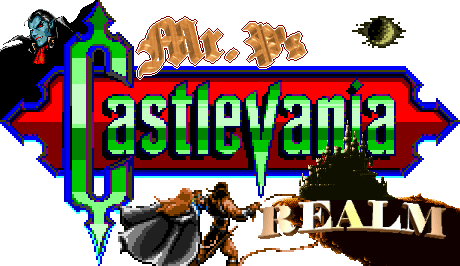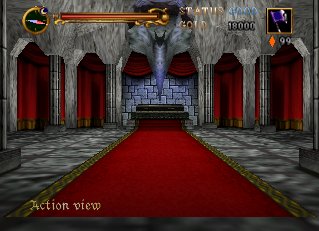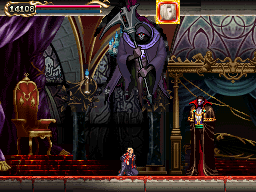
![]() Dracula's Perch
Dracula's Perch ![]()
As mentioned in the Dracula section, one thing always remains consistent in the Castlevania world: Dracula awaits a worn-down hero in his castle keep. The keep itself is usually denoted by a long stairway that leads to short window-filled hallway--it's rare that the castle keep design completely breaks away from this prototype, but there are some instances where the castle comes along with no keep. Below are only the instances where it took its prototypical form.
Vampire Killer

![]()

| The castle keep hadn't quite taken form in Vampire Killer. The simple stairway above is all there is to it. Instead of leading to the window-lined hall, it leads to an extra "area" that will be unfamiliar to anyone who's only played Castlevania. One thing is certain about the keep in future games: The moon will always be seen hovering in the background. Once you find the key to escape the area, you'll find Dracula's nesting ground where the battle will soon begin. |
![]()
![]()
![]()
Castlevania

![]()

| Not many people will notice it, but the clock tower that leads to the castle keep, as seen in Rondo and Symphony, shows up here as a simple set of backgrounds. One thing gives it away: The top of the tower seen to the right of Simon in the top-right picture. Also, the hall windows in all of the games tend to have the fence-like steel barring them. The other trend started here is the boomerang hidden in the second candle once you reach the hall, as it shows up in almost all of the sequels that emulate this area. Most of the time, Dracula awaits on his throne at the end of the keep; other times, he's in a coffin. |

![]()

![]()
![]()
![]()
Castlevania III: Dracula's Curse

![]()

| This is the first time they let you see the ocean that surrounds the castle. Before reaching this area, you do go through the clocktower, and it's very reminiscent of Symphony's and Rondo's towers, with similar designs and the pendulum jumps. The top of the clock tower, once outside, is blacked out for some reason, but everything else is close--the fence-like window bars, the boomerang in the first candle, and Dracula's debuting throne. |

![]()

![]()
![]()
![]()
Super Castlevania IV

![]()

| This is a remake of the original, so it, too, has to have that familiar stairway. The quirk here is that you can dive off the platform in the top-left picture, down onto two other hidden platforms (see here), where you'll be supplied with a boomerang, a triple-shot and 99 hearts. The top of the clock tower, strangely, seems to be missing, but the boomerang is in its usual candle. |

![]()

![]()
![]()
![]()
Akumajou Dracula X68000

![]()

| Well, in this Castlevania recreation, the top of the clock tower is back, and the fence-like barred windows have returned with it. You're higher than usual, too, as strong winds can be seen circling below, using the same scrolling effect found in Symphony, with mountains seen in the far back. Wouldn't you know it--there's a boomerang in the hall's first candle. |

![]()

![]()
![]()
![]()
Dracula X: Rondo of Blood

![]()

| One hundred years later and nothing has really changed. Dracula still loves those windows, and the boomerang is still in the first candle. (You'd think he'd learn by now.) You can't see the mountains, as you could in Dracula's Curse, but the ocean is very visible, and you can fall into it. By this time, the throne room settled in on the look in the bottom-right picture. This particular keep has a hidden stairway that you can jump onto; it rests just to the left of Richter's energy bar in the top-right picture. |

![]()

![]()
![]()
![]()
Castlevania: Bloodlines

![]()

| This game's first stage is the whole castle in its entirety. Of course, you skip over most of it and head right to the castle keep via the dried-out bones of a long-dead dragon-like creature (perhaps Galamoth, Dragon Zombies or the Wyvern?). The camera direction is different, too, so you wind up entering this area from the left instead of the usual right. The castle is a little more destroyed than usual--it either still remains from when Quincy Morris invaded, or this is as good as it looks without Dracula's dark magic giving it form. One skeledragon is stationed on the famous stairway to prevent vampire killers from climbing up and destroying the castle further. |

![]()

![]()
![]()
![]()
Castlevania: Symphony of the Night

![]()

| You actually start this game on the "final stage," which is the recreation of the final level of Rondo for those who missed it. You can come back here later as Alucard in the regular mission, but the stairway will be a little worse for wear. The set of stairs that was hidden in Rondo will be visible here if you whip the bottom-left brick of the overpass atop the regular stairway. Also, a boomerang (cross, in this case) is once again hidden in the very same candelabra. The fence-windowed hall seems to have grown into a long dining area. Perhaps Dracula's planning a dinner of warm blood? |

![]()

![]()
![]()
![]()
Castlevania 64 / Legacy of Darkness
 |
|
 |
| The two N64 Castlevania titles retain somewhat of that classic keep form. Things have changed since Richter Belmont and Nathan Graves, the two of the last travelers to the castle, have journeyed through here, and great length has been added onto it. Right after completing the clock tower stage, you'll find yourself facing that stairway of legend, with the clock tower seen right behind it--but the stairs lead you to a small observatory, which could substitute for the usual window-filled hall. Afterwards, it's another stairway that leads to another observatory. And then, it's another stairway that finally leads to the throne room, where "Dracula" awaits in his coffin. |
 |
|
 |
![]()
![]()
![]()
Castlevania: Harmony of Dissonance

![]()

| Dracula has been spending a lot of time away from his favorite area in recent games, so your venture through the castle keep within the Castle Top Floor will be without a showdown. When you enter in from the Chapel of Dissonance, you'll be at everyone's favorite staircase, as long and enduring as ever. The famous clock tower, as it was in Symphony, and the gigantic moon will be the primary visuals as you travel upward. Also missing this time is the short hallway with with the fenced windows and boomerang candle; instead, a portal room connects the stairway with the throne room, which remains in shambles from Simon's Quest. Once you find the "real castle," you'll enter this area again (bottom-right), looking more glum but bringing no new dangers. |

![]()

![]()
![]()
![]()
Castlevania: Aria of Sorrow
![]()
| You'll enter into the keep, this time, from high atop the castle's top floor. Once again, Dracula won't be awaiting your arrival; instead, Graham Jones, who thinks he's Dracula, will substitute in a way that would make the Dark Lord proud. You'll find the layout to be quite similar to Harmony's: There's a longer-than-usual stairway, separated into two smaller stairways by a short porch. The two main visuals on the outside are the moon, a swarm of bats hovering in front of it, and the outside of the clock tower, about in its rightful place. The short hallway is seemingly gone, increasingly cut off over time by the ever-growing staircase over time, but you can see the fenced windows adorning the keep's entrance (push against the overpass as a bat and look left). The throne room, though, is in its rightful place, providing a Dracula-like battle to make it worth the journey to get this far. |
![]()

![]()
![]()
![]()
Castlevania: Lament of Innocence
 |
|
 |
| So it was Leon Belmont who first braved this enigmatic feat of architecture. Once Leon exits a door on the second floor of the Pagoda of the Misty Moon, he'll find himself at that long, long staircase. Since this is early in the castle's history, there's no clock tower to be found for a visual--or at least none that Leon traveled through. However, the tower that the moon hovers above, as seen in the top-right picture, may very well be the top of the untraveled tower of gears. The skull-engraved door leads to the throne room of Walter, the site of the second-to-last battle, and its design very much resembles what would happen if the early games and the N64 offerings had a child. |
 |
|
 |
![]()
![]()
![]()
Castlevania: Dawn of Sorrow

![]()

| Though its castle is said to be a "replica," Dawn of Sorrow's castle keep stays true to the Count's hideaway in the sky. The castle keep is the extension of The Pinnacle, which isn't the final area. After breaking the seal leading to the keep, Soma will traverse the long, long stairway, with in full view the backdrop-dominating clock tower, and then enter into the game's final safety area--a shrine in place of the window-filled hall. The next room over is the empty throne room. While it follows the blueprint, missing, of course, is the Count, who's absent fin general and in this instance replaced by Aguni, who can be found hiding in the throne room's mirror. |

![]()

![]()
![]()
![]()
Castlevania: Curse of Darkness
 |
|
 |
| Curse of Darkness' castle-keep area is best described as the strange lovechild from a marriage of inconvenience between Castlevania 64 and Lament of Innocence. It has to it two parts: From the seventh floor, Hector will travel a spiraling staircase, it half-collapsed, rotting and adorned by a tattered red carpet; this staircase leads to ceremonial room pulsating with evil energy (it's here where you'll battle Isaac and Death). After the battles conclude, Hector will exit onto another half-collapsed, rotting staircase--this one carpet-less and poised to intimidate only by its cold, rocky appearance. This staircase leads the ever-present throne room, where Dracula awaits the "traitorous" Hector. |
 |
|
 |
![]()
![]()
![]()
Castlevania: Portrait of Ruin

![]()

| Portrait of Ruin's castle keep stands alone as its own area--called simply the "Throne Room." Showcased are the usual components: Jonathan will trek up the sturdy-looking long stairway, the banister decorated with currency-dropping torches and the room's upper regions home to platforms housing power-up items. The background-inhabiting clock tower is seen almost full-scale, its entire mass, shown where it's usually just the final tower. The stairway leads into an artsy shrine, as in did in Dawn of Sorrow, and then into the throne room, where the Dracula-Death dual assault will begin. |

![]()

![]()
![]()
![]()
Castlevania: Order of Shadows

![]()

| As a cell phone product, you could say that Order of Shadows is a bit more condensed than the traditional mobile game--its version of Castlevania, the legendary castle, a more compact job. Still, it's within the game's final area where we can see at least a hint of the famed castle keep. Desmond travels up the long, intimidating stairway (with no sign of a clock tower though a familiar statue seen hovering in the distance) and into a pillar-filled hallway of expected length. One final long drop lands Desmond in Dracula's throne-less domain, where the battle will soon begin. |

![]()

![]()
![]()
![]()
Castlevania: Order of Ecclesia

![]()

| Order of Ecclesia's castle keep is almost prototypical. When Shanoa reaches the peak of the Final Approach (the area that houses the keep), she can exit from the left out onto the base of the former long stairway--now having crumbled to but a few steps. The misty atmosphere sets the tone but doesn't shroud the oppressive clock tower, which can be seen standing tall in the background. The top of the staircase leads into the game's final save room, which, as is becoming a continuing theme, is a neglected shrine that replaces the usual window-filled hall. The magically sealed door will open up and invite you into the throne room, where the frisky Count Dracula sips away on a glass of warm blood. |

![]()

|
[Home] [What's New?] [CV Library] [Stages] [Reviews] [Weapons] [Castleography] [Multimedia] [Codes] [Links] |
||||
